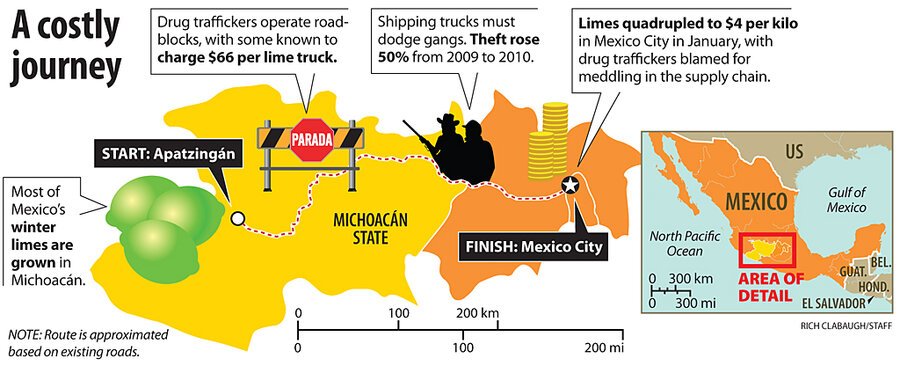Mexico drug war's latest victim: the lime
| Mexico City
Tania Tamayo's family of farmers coughs up 800 pesos ($66) to local drug traffickers for every truckload of limes they ship from the violent state of Michoacán, which supplies most of Mexico's lime market in the winter months.
The well-organized criminals give Ms. Tamayo's family a ticket as proof of payment to show to other gang members along the route to Mexico City, she says.
"All packing companies pay the money," says Tamayo, surrounded by towers of lime sacks fresh off the truck in a Mexico City supply station. Gangs also set market prices and restrict harvests to limit supplies, according to Tamayo and another lime producer who asked not to be named for fear of retaliation by the gangs.
How well do you know Mexico? Take our quiz.
At a time when war and bad weather are among many factors driving up food prices worldwide, production costs of some homegrown items in Mexico are being influenced by another element – the drug war. The lime, a staple of Mexico's taco culture, quadrupled in price at some Mexico City markets to almost $4 a kilo (2.2 pounds) in December and January, with media reports blaming drug traffickers for meddling in the supply chain.
"We feel like someone else controls our lives, but you have to learn to live like this," says Tamayo.
Lime prices have since come down, but now the price of avocados, grown in the same region, has risen. A poor harvest and increased exports are widely blamed, but one distributor told the Monitor that drug traffickers have started to target Michoacán's avocado farmers, pushing up expenses.
Be it extorting farmers, attacking produce trucks, or causing more time-consuming border inspections, criminal gangs are affecting almost every link in the produce supply chain. From farmers to shippers to resellers to shoppers, the violence is affecting the food industry.
"There are security costs that companies have had to absorb," acknowledges Beatriz Léycegui, deputy minister at Mexico's Economy Ministry.
Cargo theft rose 50 percent between 2009 and 2010, says Refugio Muñoz Lopez, director general of the National Cargo Shipping Chamber. This caused theft insurance to increase about 30 percent for trucking companies. The government now offers escorts for trucks and warehouses storing sensitive products.
Security problems have affected the flow of produce into the United States. The Arizona Department of Agriculture stopped sending produce inspectors over the border to Sonora State in November because of the rise in drug-related murders. The shift of inspection operations into Arizona caused concern among importers in Nogales, Ariz., where 45 percent of all winter fruit consumed in the US crosses the border from Mexico.
"It just slows everything down, and the product is critical. We need to get it out because it's fresh produce," says Rick Valdez of produce broker C&R Fresh in Nogales. Mr. Valdez says limited floor space at new inspection stations has delayed his workers for hours. It may get worse after adding grapes to the list of imports in April, he notes.
The Arizona Department of Agriculture is working overtime to ensure a smooth transition, and has succeeded in many cases, according to the Fresh Produce Association of the Americas. President Lance Jungmeyer says some members have incurred increased expenses by hiring guards and installing cameras, but there is no sign yet that drug violence has affected prices of Mexican imports.
Mexican officials agree: "We are sufficiently productive to keep being competitive in the United States and other markets," says Ms. Léycegui, who handles foreign commerce at the Economy Ministry.
For companies, however, these expenses take a toll.
Raúl Torres Flores, a tomato distributor in Mexico City, says once prices of Sinaloan tomatoes went up after a recent freeze, the risk of theft also increased. Robbed twice in the past three years, Mr. Torres Flores is taking no chances and sends two trucks out on the highway at one time to watch out for each other.
"You work to make a peso, only to have it taken from you," he says.
While it is not clear how much these alleged activities have affected prices in a volatile industry driven by supply and demand, Mexico's drug war, which has resulted in the deaths of more than 34,500 people in four years, is now taking a toll on farmers and produce sellers.
"All I know is that I've never seen limes this expensive," says Fernando Segovia, who has been selling fruits and vegetables at a neighborhood market in Mexico City for 20 years. When lime prices soared, consumers cut back on purchases, he says, leaving his wife to prepare generous helpings of limeade.






